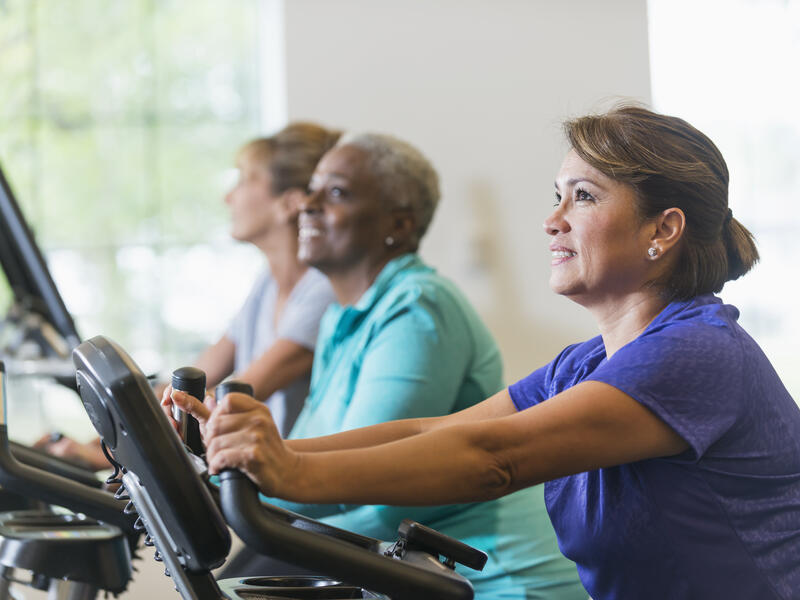Exercise is helpful for aerobic training, to increase strength, or to improve flexibility and fitness. It’s also used as therapy to restore the body to a healthy state.
Exercise is helpful for many people with cancer. Scientists are still learning about how physical activity helps cancer and what impact it has on the immune system. Too much inactivity could result in a loss of function. Most health care providers agree that regular amounts of modest physical activity can benefit people with cancer.
Find support: Cancer survivor programs at Sanford Health
Studies have shown that for some people with cancer, regular physical activity can help the following:
- Improve aerobic fitness and muscle strength
- Reduce anxiety or depression
- Reduce tiredness (fatigue)
- Improve blood flow to the legs and reduce the risk of blood clots
- Reduce pain
- Reduce diarrhea and constipation
- Prevent osteoporosis
- Reduce the risk of heart disease
- Increase overall physical functioning
- Reduce dependence on others for the activities of daily living
- Improve self-esteem
- Lift mood
What’s the right way to exercise when you have cancer?
There is no specific amount of exercise suggested for a person with cancer. The type and amount of exercise that is right for you depends on your unique abilities and what you can handle.
Overall, exercise should make your heart work harder than normal. It is important to be able to monitor your heart rate, breathing rate, and muscle fatigue. Members of your health care team — specifically your health care provider and physical therapist — can show you how.
They can also help you choose the kinds of activity that will be most beneficial. This includes exercise to help you build endurance and strength and keep your body flexible and functioning correctly.
For cancer survivors, the American College of Sports Medicine recommends the following:
- Stay active. Be sure to keep active, even when you are receiving treatment.
- Keep your health care team involved. Your health care team and fitness professionals need to closely monitor your exercise program. They can suggest the type and amount of exercise appropriate for your diagnosis. This helps you prevent injuries and safely increase your activities as strength and endurance builds.
- Aim for 150 minutes of exercise per week. When you are physically able, aim for 150 minutes per week of moderate-intensity aerobic activity.
- Adapt your exercise to your diagnosis. Types of exercise should be geared to your needs and specific diagnoses. For example, people with bone involvement may be told to not do heavy weight-bearing exercises that may result in fractures. Your health care team can help guide your exercise decisions.
Your daily routine can also provide opportunities for exercise. Walking around your neighborhood after dinner, walking the dog, washing the car, and raking leaves are all activities that can help build strength, maintain energy, and contribute to your overall well-being.
Are there any possible problems or complications linked to exercise?
Problems or complications are possible if you exercise at a level of exertion that is not advised for you. That is why it is important for you to plan an exercise program with your health care provider.
As an addition to your cancer treatment plan, exercise can be pleasant and productive. It should not replace the care and treatment provided by your cancer care team. Always talk with your health care provider with questions or for more information.
Warnings regarding exercise
Get permission from your health care provider first, before exercising, if you have any of the following conditions:
- Your blood counts are low and you are at risk for infection, anemia, or bleeding.
- The minerals in your blood, such as sodium and potassium, are not normal (which is likely to be the case if you have been vomiting or having diarrhea).
- You are taking treatments that affect your lungs or heart, or you are at risk for lung or heart disease. Watch for swollen ankles, sudden weight gain, or shortness of breath.
- You have unrelieved pain, nausea, vomiting, or other health concerns.
Precautions to consider as you exercise
Do’s and don’ts:
- Don’t overexert your body if you are taking blood pressure medicine that controls your heart rate.
- Don’t hold your breath, as this may put a strain on your heart.
- Don’t exercise on uneven surfaces that could cause you to fall.
- If you have bone disease, poor vision, poor balance, or weakness, don’t use heavy weights or do excessive weight-bearing exercises.
- Watch for signs of internal or external bleeding if you are taking blood thinners.
- If you have swelling, pain, dizziness, or blurred vision, stop all exercise and call your health care provider right away.
Learn more
- How to fit in exercise with a busy lifestyle
- Running her way through chemo with a whole crew
- Ways to help recover from chemo and how long it takes
…
Posted In Cancer, Cancer Treatments, Health Information, Orthopedics, Sports Medicine
